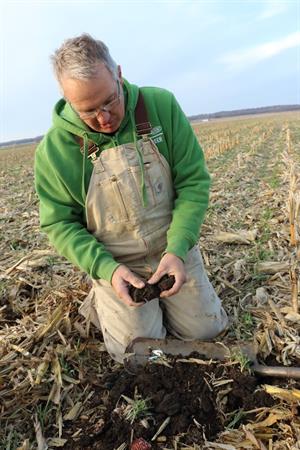Duane Hovorka, IWLA Agriculture Program Director
 When Iowa farmer Steve Berger puts a shovel into the soil in one of his fields, you can see his excitement.
When Iowa farmer Steve Berger puts a shovel into the soil in one of his fields, you can see his excitement.
“If you don’t have earthworms, there’s something going wrong,” he says as he uncovers earthworm after earthworm in one shovelful of soil. “There’s an earthworm. There’s another earthworm. There are just gobs of them in here!” Steve is excited because earthworms are one of the best indicators of soil health, and he says “the way you get earthworms is you stop tilling the soil and you start growing a cover crop.”
Soil scientists increasingly recognize that conventional farming practices – plowing and tilling the soil, heavy chemical use, cropping systems focused on one or two crops like corn or soybeans, and confining livestock in gigantic feedlots and barns – are destroying the health of America’s soils.
The organic matter of our soils, a measure of the biological health below the surface, has dropped sharply over the past 50 years. Unhealthy soils hold far less water, and even moderate rains cause a deluge of runoff into nearby streams, carrying soil, fertilizers, and pesticides with them. One result:
American farms lose 6 pounds of soil for every pound of food produced.
In contrast, healthy soils – those full of organic matter, beneficial insects, healthy fungi and bacteria – can absorb even heavy rain like a sponge, keeping the water on the land where it belongs. Healthier soils also produce healthier crops, and are more resilient to drought, insects, and disease.
Regenerating the Soil
The recipe for regenerating the health of America’s soils is straightforward: Stop tilling the soil, which destroys important fungi. Plant cover crops that keep green, growing plants on the land after harvest, with roots that feed the life in the soil. Rotate crops to break up pest and disease cycles. Reduce or eliminate the use of pesticides and chemical fertilizers. And put livestock (and their manure) back on the land. Cropping systems that use these principles can also return higher profits for farmers, but the transition from current conventional practices takes education, cultural change, and investment.
 Iowa farmer Chris Henning knows soil health can be rebuilt. Faced with a field with less than 1% organic matter – “so low in organic matter it was almost gray,” she says – she stopped tilling the land and started planting cover crops around 2010. Today, the organic matter in her field is between 4.5% and 5% – about double that of typical Iowa cropland. According to soil scientists at the University of Illinois, Henning’s soil could now hold roughly 80,000 gallons of water per acre more than it did just a few years ago.
Iowa farmer Chris Henning knows soil health can be rebuilt. Faced with a field with less than 1% organic matter – “so low in organic matter it was almost gray,” she says – she stopped tilling the land and started planting cover crops around 2010. Today, the organic matter in her field is between 4.5% and 5% – about double that of typical Iowa cropland. According to soil scientists at the University of Illinois, Henning’s soil could now hold roughly 80,000 gallons of water per acre more than it did just a few years ago.
That means that at the point when her field would have been saturated with rain a decade ago, sending runoff filled with soil, fertilizers, and pesticides into nearby streams, that field can now absorb three more inches of rain before the soil is completely saturated.
Henning got started growing cover crops with help from a Farm Bill conservation program that paid a share of the cost of planting cover crops, which can run $25 or $30 per acre. The results have sold her on the value of cover crops, but she says incentives will be needed to convince other farmers to make the investment and give cover crops a try. Farmers are planting cover crops on less than 4% of cropland acres in the U.S. (although that number is slowly growing).
Funding Soil Health
Farm Bill conservation programs are our nation’s largest single source of funding for conservation on private farms and ranches, providing $5 billion per year to help farmers and ranchers be better stewards of land and water. A primary focus of those funds should be to help farmers and ranchers adopt farming practices that restore soil health – and the Izaak Walton League is working to make that happen.
The current Farm Bill expires in September 2018, and Congress is working on a new five-year Farm Bill. When Congress wrote the last Farm Bill in 2014, it cut the budget for conservation for the first time in more than 30 years. It is critical that the new Farm Bill do more – not less – to restore our nation’s soils.
The League’s agenda for the Farm Bill, Healthy Soil, Healthy Water, proposes more funding for conservation in the new Farm Bill, and includes ideas for spending existing conservation dollars better.
The Farm Bill’s major working lands programs are the Conservation Stewardship Program (CSP) and the Environmental Quality Incentives Program (EQIP). CSP rewards whole-farm, integrated conservation systems that typically produce multiple benefits, including combinations of practices like conservation tillage, cover crops, diverse crop rotations, and reduced chemical use that will regenerate soil health. EQIP generally funds individual practices, like the installation of pivot irrigation or hog lagoons, planting cover crops, or converting to conservation tillage. The Regional Conservation Partnership Program (RCPP) combines funds from other programs, including CSP and EQIP, and targets them in a watershed, in partnership with other agencies and organizations, to fund conservation practices and systems that address high priority resource problems in that watershed.
The League is working to put more of the focus of these conservation dollars on regenerating soil health.
You can help by asking your members of Congress to support programs that restore the health of America’s soils in the 2018 Farm Bill. You can also sign up for our free e-news, Soil Matters, for updates and alerts on efforts at the federal and state level to regenerate healthy soils.
The health of America’s soil is critical to our future food supply and to the health of our rivers, lakes, and wetlands. We cannot afford to keep losing 6 pounds of soil for every pound of food we produce. The 2018 Farm Bill needs to ensure that farmers, ranchers, and communities have the tools they need to restore soil health and protect water quality.
With your help, we can restore and regenerate America’s soils.